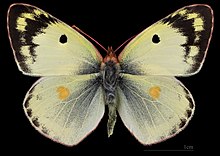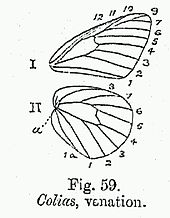| Clouded yellows | |
|---|---|

| |
| Colias hyale – type species for the genus | |
| Scientific classification | |
| Domain: | Eukaryota |
| Kingdom: | Animalia |
| Phylum: | Arthropoda |
| Class: | Insecta |
| Order: | Lepidoptera |
| Family: | Pieridae |
| Tribe: | Coliadini |
| Genus: | Colias Fabricius, 1807 |
| Type species | |
| Papilio hyale | |
| Synonyms | |
| |
Colias is a genus of butterflies in the family Pieridae. They are often called clouded yellows in the Palearctic and sulphurs (a name also used for other coliadine genera) in North America. The closest living relative is the genus Zerene,[4] which is sometimes included in Colias.

This genus occurs throughout the Holarctic, including the arctic regions. They are also found in South America, Africa, China and India. Their caterpillars feed on certain Fabaceae, for example vetches (Vicia). The adults forage for nectar.[5] most are thus beneficial by keeping weeds at bay, some occasionally become nuisance pests on crops like alfalfa. In some species, the wings of males have brilliant ultraviolet reflection, while those of females do not.[6][7] Adults of both sexes have various colour forms. Males are particularly conservative based off of their genitalia structures. These structures are difficult to identify making it difficult to classify the Colias.[8]
Most if not all species of this genus, as usual for Coliadinae, do not sequester toxins or other noxious compounds from their food plants. They are therefore a well-loved prey item of insectivores as compared to Pieris of the related Pierinae. They make up this disadvantage by being more nimble and better able to evade attacks by would-be predators.[9]
Notable lepidopterologists who did many studies on this genus included Julius Röber, J. Malcolm Fawcett, George B. Johnson and Henry Rowland-Brown.
- ^ Josef Grieshuber & Gerardo Lamas (2007). "A synonymic list of the genus Colias Fabricius, 1807 (Lepidoptera: Pieridae)" (PDF). Mitteilungen der Münchner Entomologischen Gesellschaft. 97: 131–171. Archived from the original (PDF) on 2016-03-04. Retrieved 2013-05-09.
- ^ Bjorn Petersen, 1963. The male genitalia of some Colias species.Journal of Research on the Lepidoptera 1: 135-156.[1] Archived 2017-06-03 at the Wayback Machine
- ^ Lucien A Berger, 1986 Systématique du genre Colias F: Lepidoptera-Pieridae Bruxelles: Imprimerie des Sciences, 1986.
- ^ Andrew V. Z. Brower (November 16, 2006). "Coliadinae". Tree of Life Web Project. Retrieved August 7, 2008.
- ^ Watt, Ward B.; Hoch, Peter C.; Mills, Susan G. (1974-12-01). "Nectar resource use by Colias butterflies". Oecologia. 14 (4): 353–374. doi:10.1007/BF00384578. ISSN 1432-1939.
- ^ M. L. Lim & D. Li (2005). "Extreme ultraviolet sexual dimorphism in jumping spiders (Araneae: Salticidae)". Biological Journal of the Linnean Society. 89 (3): 397–406. doi:10.1111/j.1095-8312.2006.00704.x.
- ^ Andrew V. Z. Brower (November 16, 2006). "Colias". Tree of Life Web Project. Retrieved August 7, 2008.
- ^ "View of Hybridisation in Colias butterflies (Lepidoptera, Pieridae): identification of natural hybrids using unlinked molecular markers | Acta Biologica Sibirica". journal.asu.ru. Retrieved 2024-11-22.
- ^ Robert B. Srygley & Joel G. Kingsolver (1998). "Red-wing blackbird reproductive behaviour and the palatability, flight performance, and morphology of temperate pierid butterflies (Colias, Pieris, and Pontia)". Biological Journal of the Linnean Society. 64 (1): 41–55. doi:10.1111/j.1095-8312.1998.tb01532.x.